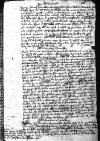Equum, quem superioribus diebus Reverendae Dominationi Vestrae per
nobilem ⌊Ioannem Lubotzky⌋, stipatorem serenissimae ⌊maiestatis regiae⌋, dono misit, vellem D V fuisset acceptissimum written over s⌈smm written over s⌉
Dominationi Vestrae, ad quam non dubito pannum, qui Dominationi Vestrae per dominos legatos promissus fuit accepisse, tandem etiam perlatum esse on the margin⌈ ad quam superinscribed in place of crossed-out Quam⌈Quam ad quam ad quam superinscribed in place of crossed-out Quam⌉ non dubito pannum, qui Dominationi Vestrae per dominos legatos promissus fuit accepisse, tandem etiam superinscribed⌈etiametiam superinscribed⌉ perlatum esse ad quam non dubito pannum, qui Dominationi Vestrae per dominos legatos promissus fuit accepisse, tandem etiam perlatum esse on the margin⌉.
Cui quod N written over C⌈CNN written over C⌉unc
quod scribere written over am⌈amereere written over am⌉m, nihil habui quam aliud, quam ut Dominationem Vestram superinscribed in place of crossed-out eandem⌈eandem Dominationem Vestram Dominationem Vestram superinscribed in place of crossed-out eandem⌉ rogarem, me quo ne desinat me indies magis ac magis serenissimae ⌊maiestati regiae⌋ commendatiorem reddere non desinat,  AAWO, AB, D. 70, f. 336v in eo apud quem si mei saepius memor fuerit, nihil mihi poterit gratius facere.
AAWO, AB, D. 70, f. 336v in eo apud quem si mei saepius memor fuerit, nihil mihi poterit gratius facere.
Quid hic apud nos fiat et quae nova habeamus, Dominationi Vestrae harum lator, nobilis ⌊Nicolaus Plutovsky⌋, quem ut D meo nomine commendatum habere written over at⌈atrere written over at⌉ velit superinscribed in place of crossed-out ro oro⌈ro oro velit velit superinscribed in place of crossed-out ro oro⌉, referet. Ex ⌊eo⌋ etiam valetudinem meam intelliget et dispositionem corporis mei inte, quod indies in viribus incipit fieri debilius, intelliget.
Cum etiam Dominatio Vestra hactenus ⌊dominis Prutenis⌋ et ⌊his terris⌋ in causa privilegiorum opera sua non defuerit,
sed eam diligenter apud serenissimam ⌊maiestatem regiam⌋
promovet written over rit⌈rittt written over rit⌉, et superinscribed⌈etet superinscribed⌉ nunc vere tempus instet quo, quo haec causa coram serenissima ⌊maiestate regia seniori⌋ tractanda per legatos nostros veniet, hoc antequam futurum est, requirent forsan serenissimam superinscribed⌈serenissimamserenissimam superinscribed⌉ ⌊regiam maiestatem iuniorem⌋, ut quod antea clementer eius maiestas pollicita est, suam eam pro nobis apud serenissimum parentem eius intercessore written over ura⌈uraoreore written over ura⌉m fore superinscribed⌈forefore superinscribed⌉ nunc benigne praestet. et In eo Quare plurimum oro Dominationem Vestram velit hidden by binding⌈[it]it hidden by binding⌉ apud eandem serenissimam ⌊maiestatem regiam⌋ exorator noster esse in eo negotio exoratorem pro nobis agere atque eidem in memoriam revocare, quo nunc, in hoc ⌊conventu Regni⌋, auctoritate eius id apud serenissimum parentem eius on the margin⌈apud serenissimum ⌊parentem⌋ eiusapud serenissimum parentem eius on the margin⌉ obtineamus, quod antea nobis saepius promissum fuit. Quod si Dominatio Vestra Hoc si Reverendae superinscribed⌈ReverendaeReverendae superinscribed⌉ Dominationis Vestrae opera effectum fuerit, experietur illa semper nostrum omnium ⌊hic superinscribed⌈hichic superinscribed⌉⌋ nostrum erga eandem gratitudinem.
Quam felicissime in valere opto.
 AAWO, AB, D. 70, f. 336v in eo apud quem si mei saepius memor fuerit, nihil mihi poterit gratius facere.
AAWO, AB, D. 70, f. 336v in eo apud quem si mei saepius memor fuerit, nihil mihi poterit gratius facere.

